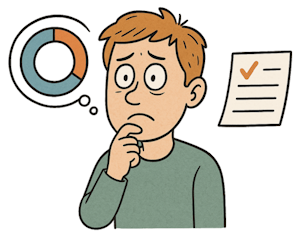Zeigarnik Effect
Unfinished tasks are remembered more; supports engagement strategies.
"People remember unfinished or interrupted tasks better than completed tasks."

Originally observed by psychologist Bluma Zeigarnik in the 1920s1, this effect highlights our tendency to better remember tasks that were interrupted or left incomplete than those we've finished. For Agile teams, this psychological pattern shows up not just in how individuals retain information but in how work in progress is emotionally and cognitively weighted. Incomplete stories, half-done initiatives, and lingering experiments can mentally crowd the team's attention. This mental clutter can shape behaviors, focus, and even perceptions of progress.
Impact on Agile Organizations
The Zeigarnik Effect2 subtly reinforces attention toward the unfinished. While this can increase persistence or focus when applied consciously, in Agile environments it often plays out in less productive ways. For example, a backlog full of carryover items or in-progress stories may create emotional friction and cognitive drag.
- Increased cognitive load from uncompleted work:
- Persistent reminders of unfinished items can lead to stress, distraction, or guilt.
- Developers may mentally "carry" work across Sprints, even if it's no longer relevant.
- Decreased satisfaction and momentum:
- Teams can feel stuck, even when velocity is consistent, due to the volume of incomplete or deferred stories.
- Product Owners may hesitate to close initiatives cleanly, fearing "unfinished business".
- Dysfunctional prioritization and overcommitment:
- Unfinished work appears more urgent than newly valuable work, distorting Backlog Refinement.
- Psychological pressure may drive teams to reopen or drag stories forward unnecessarily.
Scenario
An Agile team begins a quarterly initiative to refactor their user authentication flow. Partway through, leadership pivots focus toward customer-facing features, leaving the refactor incomplete. Each planning session afterward reopens discussions about "picking it back up," and engineers reference it repeatedly in Retros. Though the work has been paused officially, it still lingers in team consciousness:
- Developers avoid touching parts of the code that were halfway refactored.
- Sprint Planning meetings routinely include the unfinished work as a "maybe".
- The Product Backlog contains loosely scoped placeholders for future continuation.
This passive drag leads to growing frustration and a sense of unfinished commitment, despite actual priorities having shifted.
Ways to Mitigate:
By making intentional design and process changes, Agile teams can reduce the unproductive influence of incomplete work. These shifts should reinforce clarity, closure, and cognitive offloading.
- Work Structuring:
- Define smaller stories that can reach "done" in a single Sprint.
- Use clear exit criteria, even for paused initiatives.
- Backlog Hygiene:
- Regularly prune or archive Stories that no longer reflect real priorities.
- Remove speculative placeholders unless they have a scheduled return point.
- Team Communication:
- Acknowledge and name unfinished work, then explicitly defer or close it.
- Normalize saying "no" to returning to work just because it feels incomplete.
- Sprint Events:
- In Retros, highlight what was finished and celebrate that progress.
- Keep WIP (work in progress) visible, but not sticky, in review meetings.
Conclusion:
The Zeigarnik Effect reveals how Agile teams can become entangled in the emotional weight of what they haven't finished. While this instinct helps us stay driven in some contexts, in complex delivery systems it can foster distraction, guilt, or misaligned priorities. Coaching teams to consciously recognize and offload these "psychological threads" can lead to sharper focus, greater satisfaction, and better flow.
- Don't confuse emotional tension with importance.
- Closure is a skill that can be practiced.
- Naming what's unfinished gives teams permission to let go.
Key Takeaways
- Unfinished work holds disproportionate mental and emotional space.
- This effect can distort team focus, especially in Backlog Refinement and planning.
- Large or ambiguous work items intensify this psychological tension.
- Regular pruning and clear closure rituals reduce unnecessary cognitive drag.
- Effective Agile coaching brings awareness to invisible weight teams carry.
Summary
Agile environments often surface more unfinished work than traditional approaches, making teams vulnerable to the Zeigarnik Effect. When left unchecked, this can lead to a backlog burdened with emotional residue, distorted prioritization, and persistent mental clutter. By structuring work for closure, communicating transparently about incomplete items, and reinforcing healthy backlog practices, teams can release this tension and make space for clarity and progress.